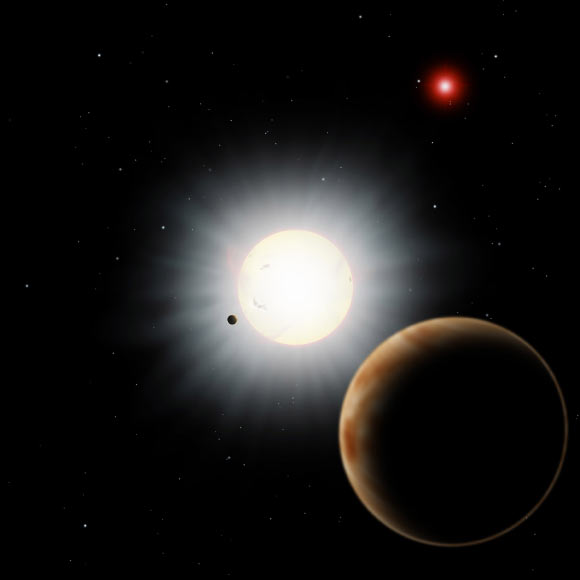Signs of powerful changing winds have been detected on an extrasolar gaseous planet called HAT-P-7b, which is 40% larger than Jupiter and orbits a star twice as large as the Sun, says a research team led by University of Warwick astronomer Dr. David Armstrong.

In this artist’s illustration, HAT-P-7b closely orbits a star that’s 1,044 light-years from Earth. A companion star (top right) and a candidate planet (foreground) lie in the distance. Image credit: NAOJ.
HAT-P-7b was discovered in 2008 by a team of Japanese astronomers led by NAOJ scientist Norio Narita.
The planet is about 40% larger than Jupiter and about 500 times more massive than Earth.
It orbits the yellow white dwarf HAT-P-7 (also known as GSC 03547-01402 and Kepler-2), which sits 1,044 light-years from us in the constellation Cygnus.
Dr. Armstrong and co-authors have now discovered that HAT-P-7b is affected by large scale changes in the strong winds moving across the planet, likely leading to catastrophic storms.
The astronomers used data from NASA’s Kepler space telescope to monitor variations in the light intensity from the giant planet as it orbits its parent star. This is called the phase-curve of the planet and the variations are caused by the day-side of the planet rotating in and out of view.
“Using the NASA Kepler satellite we were able to study light reflected from HAT-P-7b’s atmosphere, finding that the atmosphere was changing over time,” said Dr. Armstrong, lead author of the new findings appearing in the journal Nature Astronomy.
The astronomers found changes in the brightness and heat of HAT-P-7b, depending on the time of day on the planet.
At some points, the brightest part of the planet’s atmosphere was located on the morning side while during other periods the afternoon side was brighter.
The change is thought to be caused by an equatorial jet with dramatically variable wind-speeds – at their fastest, pushing vast amounts of cloud across the planet.
The clouds themselves would be visually stunning – likely made of up corundum, the mineral which forms rubies and sapphires.
HAT-P-7b could never be inhabitable, due to its likely violent weather systems, and unaccommodating temperatures.
One side of the planet always faces the star, because it is tidally locked, and that side remains much hotter than the other – the day side average temperature on the planet being about 4,690 degrees Fahrenheit (2,587 degrees Celsius, or 2,860 degrees Kelvin).
“HAT-P-7b is a tidally locked planet, with the same side always facing its star. We expect clouds to form on the cold night side of the planet, but they would evaporate quickly on the hot dayside,” Dr. Armstrong said.
“These results show that strong winds circle the planet, transporting clouds from the night side to the dayside. The winds change speed dramatically, leading to huge cloud formations building up then dying away.”
“This is the first detection of weather on a gas giant planet outside the Solar System.”
_____
D. J. Armstrong et al. Variability in the Atmosphere of the Hot Jupiter HAT-P-7. Nature Astronomy, published online December 12, 2016; doi: 10.1038/s41550-016-0004







